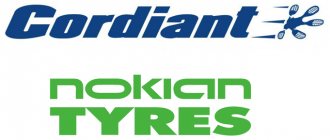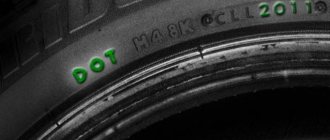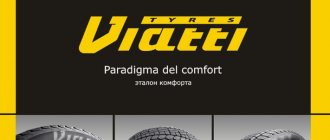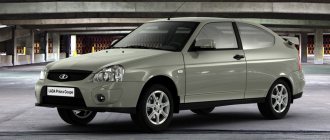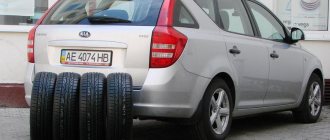Tire test result 205/55 R16 Autoreview 2020
Overall rating: 8.45. + Grip properties on ice and snow. + Cross-country ability. + Grip properties on wet asphalt. — Grip properties on dry asphalt. — Insufficient level of comfort. Number of studs: 170. Stud protrusion: 1.1 mm.
The number of “curly” studs was increased to 170, and at the same time, control over the quality of studs was strengthened (it is made in Russia, in isolation from the main production in Korea).
When braking on ice - second result! Only leader tires are better. Good grip properties on snow. All that remains is to improve the handling: both on ice and snow, the reactions lack clarity, especially when entering a turn.
Hankook tires do not shine on asphalt: there are complaints about both noise and smoothness, but the main puncture is weak deceleration during emergency braking on a dry surface.
For snow and ice it’s what you need, but for city driving it’s not the best option.
The result of the test of studded tires 205/55 R16 “Behind the wheel” 2020
873 points. + Better longitudinal grip on snow. + High lateral grip on ice. + Economical at any speed. + Satisfactory ride quality and directional stability on asphalt. — Difficult directional stability on snowy roads and handling. — Low level of cross-country ability. - Noisy. How many studs: 169. Protrusion of studs before tests: 1.2...1.7 mm. Protrusion of spikes after tests: 1.4…1.7 mm.
For any winter roads. Helps save fuel.
Studded tires are winter tires equipped with metal inserts (studs). They provide rubber grip on ice or snowy roads. Car studs have two components:
- An interspersed rod responsible for reliable fastening of a metal insert to a car tire. The more serrations the rod has, the less risk it will fly out of the wheel.
- The core of the insert, which consists of an alloy of the most durable metals to ensure high-quality adhesion of the tire to the road surface. The core, as the main part of the inclusion, protruding from the rubber, is its main part, because it clings to ice or compacted snow.
Standards for the number of studs in a car wheel
The number of spikes until 2013 was determined as follows:
- For tires with diameters R13 and R14 – up to 90 metal inserts per wheel.
- For tires with a diameter of R15 – up to 110 studs per tire.
- And wheels with a diameter of R16 could have up to 130 inserts.
The Scandinavian countries made changes to these values in 2013. The permitted volume of studs per tire was changed due to the need to reduce the negative impact of metal inclusions on the quality of the road surface. The second reason for the adjustments was the harm caused to the health of citizens due to dust flying from the sites of road destruction. The editorial addressed the following points:
- Reducing the volume of metal inserts on a tire to 50 pieces per linear meter.
- Test resolution proving that the density of metal inserts, higher than the previous recommendation, does not harm the road surface.
Types of studded wheels
Taking into account the listed instructions, the following types of tires are distinguished depending on the number of studs installed:
- Tires with steel inserts up to 50 pieces per linear meter.
- Tires that have retained the same number of metal inserts, namely about 130 pieces per wheel.
- Rubber that has a significant number of studs, i.e. from 170 pcs to 190 pcs per tire.
What does the number of inserts in rubber affect?
The main point of impact of the studs is the adhesion of the car tire to the road. According to various tests, a predictable conclusion has been revealed: the more metal inserts on the wheels of a car, the shorter its braking distance. However, currently this parameter is achieved by manufacturers with a number of studs of 96 pcs. How? A car tire is equipped with other factors that affect grip: high-quality rubber composition, a unique stud installation or a different lamella pattern.
Which winter tires are better than Michelin or Nokian?
17.09.13The results of braking tests on a car equipped with good winter tires showed that the braking distance is on average 30% shorter compared to summer tires.
Regardless of the type of drive the car has (be it a sports car, front-wheel drive sedan or all-wheel drive SUV), the most important safety feature of any car is the contact patch - this is the part of the tire that comes into contact with the road.
Many people say that an all-wheel drive car will completely solve the problem of traction in winter - so they save money when it comes to buying tires (and then slide like on a skating rink, sometimes covering it up with the loud name “professional drifting”). No amount of supernova, cutting-edge nanotechnology in the world can provide a true replacement for winter tires when it comes to good traction. Only real winter tires will provide normal traction.
At the moment, the leaders in the winter tire market are such well-known companies as Michelin and Nokian Tires (Nokian tires). Practically any model of these brands is the best choice. Both companies belong to the premium segment and a single tire of approximately the same price category will have similar qualities. Here the choice depends only on you - preferences, approval, brand support, independent assessment - all this is a personal matter for everyone, as they say: “There are no comrades for taste and color!” Therefore, when choosing one or another brand from those listed above, you will not receive either amazing advantages or terrifying disadvantages (in any case, your choice will be at the same level, and it will be simply impossible to find something better for the same price).
Michelin "car shoes" are highly valued all over the world (by both car enthusiasts and car manufacturers), especially due to their reliability, durability and safety. In all respects, the company outperforms analogues of less common brands. As for Nokian, they are actually in no way inferior to Michelin, not at all. Even more, maybe Nokian tires are not so widespread on a global scale, BUT Nokian creates tires mainly for severe climatic conditions (which corresponds to our winter period). You shouldn’t make hasty conclusions like: “Nokian doesn’t sound as cool as Michelin, I’ve never even heard of such a brand” or “Michelin tires are not so good in winter,” both companies employ specialists, so the quality is independent from the brand, will be at the highest level. Regarding the tires directly: yes, the factual figures cannot coincide 100%, so the braking distance may differ, and in general there will of course be a discrepancy in the characteristics, BUT it is not so significant that it would immediately discard one or another contender, especially since it is not There is no ideal tire, they all have their advantages and disadvantages.
The choice is made by you and only you; what to choose is at your own discretion. IN ANY CASE you will win. No one will complain about the disadvantages, even just because you will have premium brand tires. So don’t be afraid to choose the wrong thing, don’t listen to fanatics and brand sectarians (they still don’t see anything further than their favorite brand), but buy what you like, what you can afford and what fits your parameters. After all, choosing tires is no different from choosing anything else; all products of the same price category occupy the same niche in the market. So when choosing between premium brands, you won't get more options, better designs or any other benefits of the same kind. Everything always depends on the buyer, his needs and wishes (it’s not for nothing that his word is law). So if you choose something in the end, you will be satisfied.
In conclusion, it remains to highlight the main points when buying winter tires:
1. Top brands = Michelin and Nokian.
2. Choose a model specifically for your vehicle!
3. Don't be afraid to choose between brands.
4. Buy with confidence.
Do not forget, no matter in whose favor your preference falls, you are guaranteed to be satisfied in any case. So choose, select, buy, enjoy and rejoice! Sections / Winter tires
Why so many thorns?
During testing, such “multi-studded” tires had the best or very good performance on ice: braking, acceleration, and handling. More often than not, you get good performance on snow as a bonus. However, on the other side of the coin is noise.
What is the real difference in performance on ice between different tires, depending on the number of tires? Autoreview experts measured the braking distance from a speed of 20 km/h (using ABS).
The spread between the three tires from this rating is 30 centimeters (the difference between 5.9 and 6.2 m), and between all studded tires it is 1.6 meters.
Top 3 tires with the most studs
So, the first place in our rating is 190 studs : Nokian Hakkapeliitta 8 and Continental IceContact 2. They have twice as many studs as the others! Nokian wins winter tire tests more often than others. These tires have the best performance on ice, snow and snowy roads. The Continental is also an excellent tire with balanced characteristics, without failures. Their uniqueness lies in the technology of vulcanization of the studs.
Second place - 170 studs : Hankook Winter i*Pike RS+. Additional advantages of Hankuk: low fuel consumption, traction on ice, snow and wet asphalt.
Spikes and diamond shavings. Supertest: 14-inch winter tires
Last winter in Moscow turned out to be warm: we barely had time to finish testing winter tires when the snow melted at the Dmitrovsky training ground. But we were once again convinced that even in mild winters, tires labeled M+S remain relevant. We will choose from fifteen models: nine with spikes, five without spikes, and one with “diamond” shavings! In addition to the M+S marking, all these tires are united by the fact that they are all the most popular VAZ sizes (175/65 R14 and 185/60 R14) and almost all are relatively affordable: along with domestic ones, budget import models also took part in the test .
The domestic industry is represented mainly by studded tires: Amtel Nord Master 2, Cordiant Polar and Cordiant Snow-Max, Matador Sibir 2, Fortio WN-01, Kama-516. Of the non-studded tires of the required dimensions, we found only one model - Amtel Nord Master CL.
The near and far abroad in our test are represented by the Korean tires Kumho I'Zen KW-17 and Hankook Icebear W440, the Slovakian Matador MP-58 Silika, the Japanese Yokohama IG 20, the Ukrainian Rosava WQ-102 and the Swedish Green Diamond - the same ones with Carborundum and aluminum oxide shavings are used for the tenons. As the advertisement claims, these shavings are as hard as diamonds and do the same job on ice as regular spikes. Shall we believe it? No, we better check!
Another test participant is the Nokian Hakkapeliitta 5 studded tires. They are, of course, noticeably more expensive, but they also have a different mission: in our test they are the standard, the reference point. By the way, it’s nice to mention that this standard is “Russian-assembled”: the tires were produced at the plant in Vsevolozhsk.
We conducted tests on the editorial Chevrolet Aveo sedan: it is equipped with ABS, which will allow a more accurate assessment of braking properties, minimizing the influence of the “human factor”. After we measured the weight, tread depth, number and offset of studs, the tires were mounted on identical alloy wheels and, of course, balanced. Balancing is also part of the test: the smaller the weight of the weights, the more uniform the tire is. Most tires were balanced at a cost of 40-60 grams per wheel, and only Green Diamond tires required almost a hundred grams of lead! Why? The answer is in the words Retreaded, Runderneuert, Pinnoitettu, printed on the sidewalls. Translated from English, German and Finnish it means “restored”. That is, only the tread in these tires is new, and the frame (the power skeleton of the tire) has gone to the second round. But the “gain” promises “gain”: Swedish tires are offered at the price of domestic ones!
How many studs should there be on winter tires R16, R15, R14?
Author:
Maxim Markov
Winter tires come in different types - non-studded (the so-called “Velcro”) and equipped with studs that increase the traction properties of the tire. Spikes are metal cylinders of round or multifaceted cross-section, which are installed in special recesses in the tread. They are arranged on it in several rows and at equal intervals, forming a certain pattern. However, depending on the size of the tire, their number should be different, because the circumference increases with increasing diameter. So how many studs are there on winter tires R16, R15, R14?
Quantitative norms
As already mentioned, studs are not installed on all winter models - in some countries they are prohibited by law, and in certain climates the use of such rubber is simply not necessary. But more often the law clearly stipulates their number per linear meter of tire. In Scandinavian countries, there is a standard of 50 studded tires. But there is a caveat that the manufacturer has the right to install more of them if he proves that such a wheel does not destroy the road surface more than the standard one.
Scandinavian countries are ahead of everyone in the development of safety systems, so here, too, tire manufacturers were able to bypass their own law and install as many as 190 studs on the most advanced Nokian Hakkapeliitta 8 tire, which is close to the limit of the number of their installation. Naturally, tests confirm the safety of such rubber for the road, and also show exceptional braking properties on snow and ice. The cost of such tires, oddly enough, is at the level of their competitors (from 3 thousand rubles for an r14 tire).
Japanese and Asian manufacturers do not legally limit the number of studs in wheels. These tires (Bridgestone, Yokohama) have about 130 of them on one tire. For domestic tires, the number of studs is closer to the maximum and ranges from 130 to 160 pieces per tire, since there are no restrictive laws in our country.
How many studs are allowed on a winter wheel in different countries, why
In principle, there is no exact figure. The answer depends on individual operating conditions. The country of origin plays an important role, as does the company that produces studded wheels. This is due to the legislation of different states. In some there is a strict limit on the number of studs, in others it is forbidden to use them at all, and it is only possible to ride on Velcro.
Countries of Europe
Tires with studs are only permitted in Scandinavian countries. In Europe, where it is always warm, studded wheels are prohibited by law. This is due to the road surface, which begins to collapse due to their hardness.
There are countries where the law requires a certain number of studs. On one linear meter of a wheel there should not be more than 50 of them, that is, within 96 pieces. over the entire surface.
Rubber supplies to Russia are carried out from different countries. In addition to manufacturers from Europe, you can see tires from the USA, Japan, China, and Finland. For example, the Finnish company Hakkapeliitta produces models with 190 studs. Russian manufacturers set 120-180. If we take the average tire sizes R14 - R15, 96 is installed.
It must be said that if there are a lot of thorns, this is not always good. The car listens worse to the steering wheel, the rubber fails faster due to damage, since manufacturers always try to reliably install the claws so that they do not fly out during the first days of use.
Asian region
The main manufacturers of studded tires in Asia are:
- Korea,
- Japan,
- China.
In these countries there are no strict conditions, so each manufacturer decides for himself how many claws to put on his product. In Japan, it is not customary to install many studs; companies limit themselves to 130. The most famous manufacturer of such wheels is the Japanese company Bridgestone.
Russia
In our country, similar to Asian ones, there are no restrictions. Therefore, their number is in the range of 130-190.
And if some of the studs fell out, is it possible to use such tires? Before answering this question, it is necessary to determine what percentage of the spikes fell out. There is a simple formula for this:
W x 100: H = %, where:
- The number of remaining spikes is W.
- How much was there - V.
The resulting percentage determines the suitability of the tire for winter use.
5%
You can ride with confidence. Typically, such loss is associated with the transportation of wheels. The loss of some studs does not have a serious effect on the grip properties of the rubber.
10%
Rubber can be used. Typically, a small number of spines are lost during the first two seasons. The change in adhesion properties is minimal.
20%
Absolutely normal wear and tear if the car has been on such tires for three seasons. No tire replacement required.
30%-40%
Average wear. The adhesion of rubber to the road surface is significantly reduced. The braking distance increases slightly, the car feels unsure when cornering and at high speeds. According to the manufacturers, you can drive on such tires.
50%-60%
We can talk about severe wear of the wheel. It should only be used as a last resort. Moreover, it is prohibited to place such a tire on the drive axle. Only new tires are installed here.
More 60%
You can't drive on these tires. The car has almost no grip on the road and behaves unpredictably.
Wheel radius
R13
Installed on almost every rear-wheel drive VAZ car. Today these are the most popular studded models. No more than 110 spikes.
R14
Today, R14 wheels are gaining great popularity, since all new AvtoVAZ models are equipped with wheels with this radius. Even budget cars - Lada Priora, Kalina, Granta, Vesta - are equipped with R14 wheels. Similar to R13, equipped with 110 studs.
R15
Almost all foreign cars ride on such tires, regardless of the country of manufacture. Nordman 5 has 110 studs. Exactly the same number is found in Bridgestone, Gislaved, Kama, Cordiant tires.
R16
Installed in winter on foreign class C cars. A prominent representative can be considered the Chevrolet AVEO. The number of claws reaches 108.
R17
Installed on luxury cars or SUVs. The Goodyear Ultragrip tire has 130 studs.
What is affected by the quantity and quality of spikes?
Metal inserts on the tread perform several tasks:
- Increased traction on snow
- Increased cross-country ability on loose snow and above-zero temperatures.
- Increased stability on ice, reduced slipping at start and shorter braking distance.
In general cases, with a larger volume of studs located in the area of the contact patch with the road surface, the adhesion properties also increase. Numerous tests of the best winter tires confirm this.
However, at present, progress does not stand still and the latest models of studded tires can boast of significantly fewer of them, which, however, show the same results when braking on ice. Such specimens differ from other models in a qualitatively different composition of the rubber mixture itself, which has different adhesion properties.
Number of studs on tires of different sizes
Although there should be more studs as the tire diameter increases, this is not always the case. Oddly enough, an increase in diameter does not lead to a directly proportional increase in their number, but remains approximately at the same level.
So, for tires with size r14 there can be an average of 110 of them, and this is quite a lot. On such a tire they are installed in at least three rows. On tires size r15 (the most popular size on budget foreign cars at present), the number of studs also remains the same, even if they are tires of the same model, because the size of the “checkers” on the tread increases. So the diameter of the tire does not greatly affect their number. Wheels with r16 tires (most C class cars) have the same number, and it all depends on the manufacturer.
How many studs should there be in a rubber?
After driving for three or four seasons on winter studded tires, there is a need to replace these tires due to their natural wear. However, when you get to a tire center, you can find that there are fewer studs in completely new tires. What is the reason for this and how does a smaller number of studs affect the performance properties of the wheels?
Game by new rules
Relatively recently, namely on July 2013, new rules regarding tire manufacturers came into force. According to the new regulations, there should not be more than 50 studs per linear meter of rubber, and the figure does not depend on the width of the tire. This means that, for example, the most popular winter tire of 16 radius will have 96 studs, although up to this point there could have been 130... At the same time, the protrusion of the studs above the tread is still 1.2 millimeters.
It is unlikely that the new standards will have a positive effect on the grip qualities of tires. But the initiators of the restrictions were not faced with the task of bringing this parameter to a new level. The main emphasis of using winter tires with fewer studs is to maintain the good condition of asphalt roads.
True, not all tires are available with a limited number of studs. There is also an option with 190 spikes (16th radius). It is worth noting that the spikes themselves in this case are smaller in size, which means that this configuration will still be of little use.
Comparative tests
Methodology
And yet, tires with what number of studs are most preferable? To understand this, you need to look at the test results. The tests were carried out by a group of experts using a method developed by a Scandinavian institute.
The essence of the test is to drive a car over a special granite tile: two hundred runs in one direction, two hundred in the other, opposite direction. First, a car with the allowed number of spikes (96) passes, and only then the subjects (130, 190). After one run, consisting of a set of passes in two directions, the tiles are weighed.
If the races on the test tires were not able to reduce the weight of the tiles more than on the approved tires, then tires with a large number of studs are allowed for mass production. Below are the test results for 16-radius wheels.
| Number of studs in a tire | 96 | 130 | 190 |
| Braking distance on ice from a speed of 25 km/h (m) | 11,8 | 10,5 | 10,7 |
| Acceleration on ice up to 25 km/h (sec) | 4,9 | 4,1 | 4,4 |
| Timed lap, ice surface (sec) | 26,8 | 26,6 | 25,8 |
| Braking distance on snowy surfaces from a speed of 50 km/h (m) | 26,5 | 25,9 | 26,1 |
Result: During the tests, it was clearly demonstrated that tires with 190 studs are a compromise option - they show good results in both acceleration and braking. Therefore, for use in winter conditions it is better to prefer just such wheels, provided they are available in tire centers.
shiny-info.ru
conclusions
Thus, the wheel size has virtually no effect on the total volume of studs in the tread. Even in tires of sizes r17 and r18 there are not much more of them. Much more important is the quality of installation, their shape, as well as the properties of the rubber itself.
It’s no secret that over time (and often after the first season) they begin to fall out, and by the end of their service life no more than a quarter of the original amount remains. Of course, this will happen much earlier than the wheels turn into bald tires, but, firstly, the tread can be re-cut, and secondly, new studs can be installed to replace the lost ones. And we should not forget about comfort while driving.
A larger volume of studs always leads to increased noise while riding. Therefore, no matter what results winter tires show on ice and snow, the increased noise factor will remain in any case. And when choosing specific tires for your car, you should be guided by all aspects and performance indicators of the product.
How many studs are on the wheel?
Question from a reader:
“Good afternoon Sergey, I immediately want to thank you for your site, it’s just a godsend for me. Help with advice! I bought a used car in the summer, the former owner gave it winter studded tires, I threw them in the garage and didn’t really look at them until the cold weather. Now winter has suddenly arrived, I decided to change my shoes. I looked at the tires, and they were really tired, a lot of spikes had fallen out! What to do? Do you recommend driving with these wheels or buying new wheels? Thank you, Vlad"
Your question is clear. Indeed, the question is relevant and many drivers are thinking about it, let's think about it together...
I will say this - if all the studs have fallen out and not one is left, then driving on such tires is dangerous. It's worn out and of no use! This needs to be understood! And in such extreme conditions as winter, a new tire is definitely needed. After all, she clings to the ice covering with these very “spikes”, like claws!
Reviews about winter tires
Konstantin, Volgograd
“I purchased Yokohama Ice Guard as soon as it went on sale. I have used other models from this company before and I like them all. The tires are still rolling well, no complaints.”
Igor, Samara
“I drive the Continental, the third season is coming, everything is fine. They make a little noise, sometimes they don’t start right away if there is a lot of snow under the wheels, but overall everything is fine. I drive around the city and don’t go into hard-to-reach places.”
Kamil, St. Petersburg
“I took Michelin on my head. It was highly praised in the reviews, but in reality it turned out to be an unrealistically noisy tire that copes poorly with the road. The only plus is that the spikes are in place after 2 seasons, but the price is simply exorbitant.”
Anna, Ryazan
“I spent a long time choosing winter tires between continental and domestic Kama. I've been driving recently and don't have much advice, so I had to read reviews and go shopping. I still chose Kama and didn’t regret it. The wheels are reliable and have never let me down. The seller recommended the Euro 519 model, all the studs are in place.”
Kirill, Moscow
“I took a Nokian Nordman 7 Sun for an SUV. I realized that it was possible not to purchase such powerful tires for the capital’s roads, but I often drive in other regions, and they really save me. It handles maneuvers well, everything suits me, I think it will take a couple more seasons.”
Anatoly Ivanovich, Vitebsk
“I’m a fan of domestic products, I only take Kama. This is not the first season that wheels have come to the rescue. Another big plus is that no one will particularly covet it, so I don’t worry about being “taken off.” I recommend it to anyone who cares about quality, not brand.”
Igor, Krasnodar
“Our winter is mild, so I take Bridgestone Velcro. Handles wet roads well, the price is normal, it has never let me down. This season it’s time to change, I think I’ll buy the same tires again.”
Reviews about winter tires will be constantly updated!
You can also read on this topic:
The car structure is not as complicated as it seems
Tuning VAZ 2111 - elegance and comfort of the car
How to save gasoline using special additives
TOP 10 best car batteries
Restyling of the Ford Focus 2 sedan: updated look and new qualities
Share on social networks
Dmitry Seregin October 16, 2017
Published in: Useful tips and car devices
Tags: rating, Tires
